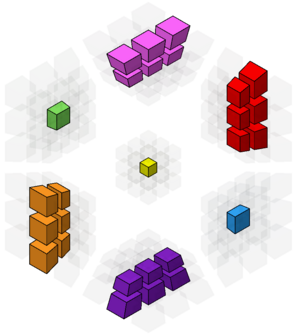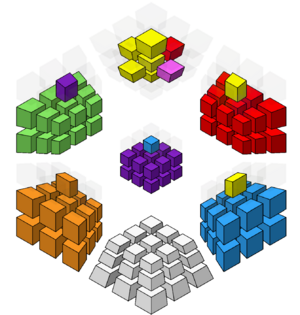3-Block
3-Block is a method designed for quickly speedsolving the 3^4. The former speedsolving record of [7:43.33] by HactarCE was set using this method. It was primarily invented by Luna and HactarCE, and has been described as "ZZ without EO".
Contents
4/6 Cross
Solve 4 out of the 6 cross pieces, with the cross colour being on the O cell. The unsolved cross spots will be on the Left and Right.

Belt F2L
Create and insert 4 F2L-a (2c3c) pairs into the 4/6 cross. This will solve 2/3 of the M slice. Because the Left and Right cells don't have their cross pieces, you can use them to aid with building and inserting the pairs.

Left
Solve the Left cell. This is done in 3 blocks, hence the name of the method. The first block consists of the cross edge, followed by two 2c3c F2L-a pairs. This solves the middle column of the left cell. The final two blocks consist of a 2c3c pair, and two 3c4c pairs.

Right
Solve the Right cell. This is also done by breaking it up into the 3 blocks, except now you don't have an empty opposite cell to aid you in making pairs.

OLC
The last cell is oriented, as in Sheerin-Zhao Method. This is typically done by first orienting the 2c's, then 3c's, then 4c's, however the solver may wish to make use of setting up to big 3D OLLs, or use 4D specific algorithms if a case presents itself.
2cOLC
Orienting the 2cs is a simple matter of using standard OLL algorithms. This can always be done in 2 algorithms or less. The first one should try to orient as many as you can while also making sure that there are 2 oriented opposite of each other. After that, a standard 3D case should appear. The image below would need the algorithm F U R U' R' F' (without RKT).

3cOLC
RKT is used to set up standard 3^3 OCLL cases with 3c's on the E slice. Then you do the big version of the OCLL algorithm to orient those 3c's. There are 12 3cs on the last layer, so in the worst possible case of all 12 are not oriented you would have to do 3 algorithms. This is because you can orient 4 corners at once using the H or Pi OCLL cases.
4cOLC
RKT is used to set up a standard 3^3 OCLL case, but this time to the 4c's on the D layer of the last cell. Then Once you rotate I->U, You use OCLL algorithms, but this time using RKT. For speedsolving, you can learn the OCLLs with RKT cancelling to lower the movecount. This step can always be done using 2 or fewer OCLL algorithms.
PLC
The last cell is permuted, as in Sheerin-Zhao Method.
2cPLC
With the last cell at U, use EPLLs such as U, H, or Z perms to solve the 2c's relative to each other.
3x3PLC
RKT is used to solve the last cell like a 3x3x3. The recommended way to do this is with CFOP, as you arrive at this step without getting to inspect it like a 3^3 solve, and finding 4 cross pieces is easier to quickly find. Whereas counting edge orientation or planning a first block would take too much time.